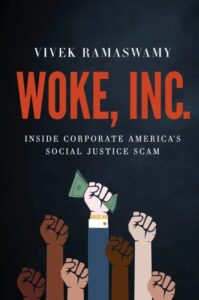Aug
20
CDT: A New Movement for True Corporate Diversity
“The Church of Diversity waxes strong. All must be cleansed; all must be saved.” — Vivek Ramaswamy, Woke, Inc.
As I have said before, Vivek Ramaswamy is not my first (or second, or third) choice among the GOP’s current presidential candidates. But, he is anti-woke, and I think he has some good ideas. So, I would share this stuff even if he wasn’t running for office. (This is the last excerpt from Woke, Inc., I promise.) Hope you give it a read…
— — —

“The war for academia has already been lost. When identity politics took down Larry Summers in 2007, it was a sign that wokeness had won at the highest levels and it was time to begin the mop-up action. Now, having won everything they can win in universities, grievance studies and critical theories are turning to new battlegrounds: corporations and governments. And they do it all under the banner of Diversity.
Institutions including companies, nonprofits, and government agencies are increasingly adopting implicit and explicit approaches to foster greater diversity in their ranks. In principle this is a good thing: diversity of thought improves the quality of decisions in most organizations. However, in recent years, many organizations have resorted exclusively to using genetic characteristics as a proxy for diversity of thought — relying on metrics such as race and gender as the exclusive barometers for measuring diversity in the leadership of an organization.
The approach is flawed on multiple levels. First, when institutions conflate racial and gender diversity metrics with diversity of thought in their organizations, they implicitly reinforce the incorrect assumption that genetic characteristics predict something important about the way that a person thinks — the most fundamental assumption underlying racism itself. Second, this approach empowers entrenched managers to create the visible appearance of diversity in their organizations while avoiding the need to engage with true diversity of thought, including challenges to their incumbency. Third, when a narrow conception of diversity is implemented through affirmative action or other quota-based systems, that fuels racism and sexism by fostering tokenism in the work-place and animus among communities that fail to benefit from these programs.
Notwithstanding these flaws, institutions are relying increasingly on racial and gender-related characteristics as the exclusive basis for measuring and implementing diversity in their organizations. Today leaders who fail to adopt this narrow approach are publicly vilified. However, these same leaders have also failed to offer alternative ways to measure and implement true diversity of thought in their organizations.
I propose a new movement to resist the enforcements of race- and gender-based diversity metrics across institutions by offering a new vision for achieving true diversity of thought in any organization. This new movement aims to more effectively achieve three essential objectives: (1) define what types of diversity of thought are important to an organization, (2) measure diversity of thought in an organization, (3) select for diversity of thought when hiring leaders to scale an organization.

I call this ‘critical diversity theory’ (or CDT) to reflect its critical perspective on the prevailing narrative of racial and gender diversity, in response to intellectual movements such as critical race theory and critical feminist theory, which spawned this narrow conception of diversity. Critical theory refers to an approach to inquiry that reveals and challenges power structures. CDT should follow this tradition by challenging the new power structure created by critical race and gender theory itself — one that has weaponized a narrow conception of diversity to implement a monolithic social agenda that is increasingly intolerant of dissent and agnostic to the institutional purpose of an organization.
CDT challenges this new power structure in a simple way. The first fundamental premise of CDT is that different organizations ought to approach diversity of thought in different ways depending on their institutional purpose — that is, by taking diverse approaches to the question of diversity itself. The second fundamental premise of CDT is that the most effective way to achieve diversity of thought in an organization is to screen candidates for the diversity of their thoughts, that the most effective way to achieve diversity of experience is to screen candidates for the diversity of their experiences, and that the most effective way to measure diversity of thought or experience in an organization is to measure the diversity of thoughts or experiences in that organization — without regard to genetically inherited characteristics such as race and gender.
CDT must become an interdisciplinary movement to succeed. As a starting point, this new movement will require leaders of companies, nonprofits, and government institutions to work together to create new methods of measuring and implementing true diversity of thought in their organizations. I propose a multidisciplinary collaboration between leaders of these organizations, working in conjunction with academic counterparts to develop measurable tools that any organization can implement to assess and advance diversity of thought in a way that is best suited to its own organizational purpose.
This will not be an easy undertaking: one reason that race and gender have become the predominant metrics for diversity is that they are simple to measure and implement. By contrast, true diversity of thought is difficult to achieve, especially when coupled with an organization’s need for employees to align around its goals. A well-run organization requires not only diversity of thought but also an unwavering commitment to its mission and principles. These goals are necessarily in tension with one another, at least in some measure.

For example, one of Roivant’s business principles is ‘be contrarian’ — that is, challenge conventional wisdom when necessary. It’s impossible to create an environment where people challenge conventional wisdom if everyone thinks in the same way. So we value diversity in the ways people think — some who craft arguments, some who are expert at interpreting data, and so on. That’s one form of diversity of thought.
But another of our business principles is to ‘climb the wall’ — that is, to work hard to overcome obstacles. We don’t want diverse attitudes with respect to their willingness to do that. Our main goal as a company is to develop medicines faster for patients who need them. We don’t want diversity in our employees’ commitments toward that goal. That’s something that everyone at Roivant should be equally committed to. Applauding ‘diversity’ ad nauseum is easy, but defining what type of diversity each organization should desire is much more important.
That’s what CDT is all about: it forces institutions to define their true purpose. This new movement requires leaders of organizations to openly acknowledge the areas in which they seek diversity of thought while also defining the areas in which they prioritize organizational alignment over diversity of opinions. These are fundamental questions for any organization to answer. Diversity of thought is important, but only insofar as it helps an institution realize its true purpose.
Skin-deep diversity metrics like race and gender often subvert true institutional purpose in a woke world by supplanting that purpose with the activist goals espoused by critical race and critical gender theorists. By contrast, CDT invites leaders of organizations to actually use diversity — in particular, diversity of thought — to define the true essence of an organization by defining the areas in which diversity of thought is desirable and the areas in which it is not.
The answers to these questions will inevitably vary across organizations, and that’s good. These are the very differences that allow one institution to distinguish its purpose from that of another. Institutional pluralism is at the heart of American pluralism. Universities educate students, pharma companies make medicines for patients, banks lend money to borrowers, charities help people in need, museums memorialize history, orchestras perform music, Congress makes laws.

They don’t all do the same thing, and we shouldn’t want them to. That we have so many different institutions with distinct purposes is part of what makes our society vibrant. That’s true diversity. Regardless of our attitude toward woke values — whether we love them or not — we should be dubious of dissolving true institutional diversity in favor of any homogeneous social agenda, even if that agenda masquerades in the name of Diversity itself.
Here are five key principles that can serve as the foundation of this new critical diversity theory movement across our institutions. These principles are simple, not complicated; implementing them will be hard, not easy.
Excellence, Opportunity, and Civility — an Alternative to ‘Diversity, Equity, and Inclusion’
1. Excellence First. Diversity is not an end in itself, but a means toward achieving excellence.
2. Institutional Purpose. Institutions should define their own unique purpose and define what kinds of diversity they seek — and do not seek — in order to pursue their purpose.
3. Institutional Pluralism. Nonprofit institutions may have conflicting perspectives on important social questions. That’s a good thing: institutional pluralism is part of American pluralism.
4. Separation of Corporation and State. For-profit companies should focus exclusively on making products and providing services for profit, not on advancing unrelated social or political agendas.
5. End Discrimination. The best way to stop discrimination on the basis of race is to stop discriminating on the basis of race. [Read that again until you get it.] Same goes for gender and other inherited attributes.”
— — —
Ramaswamy offers a solution to eliminating the wokeness in American businesses. But, he admits it can’t be realized overnight. “These principles are simple, not complicated; implementing them will be hard, not easy.” I think it will be even harder than he thinks, as there is a “hearts and minds” issue that isn’t being recognized. But, if Ramaswamy can get some heavy-hitters in the business world to join him in advocating for CDT, hopefully they can at least get some momentum toward making positive changes in the corporate world.
What do you think?















